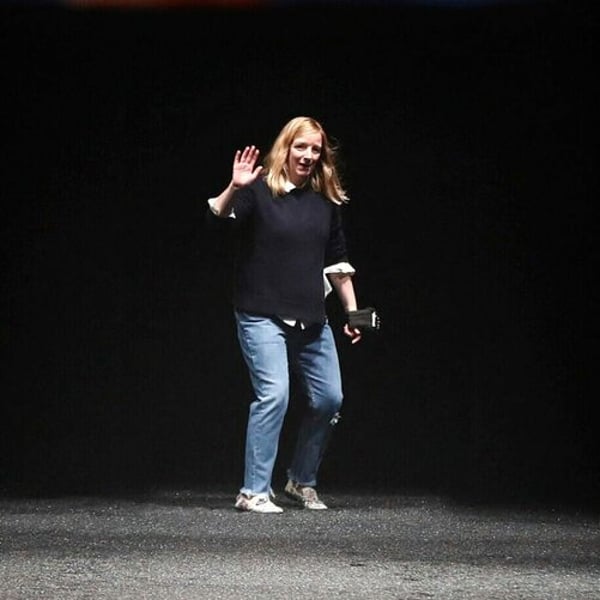Translated by
Cassidy STEPHENS
Published
Sep 18, 2023
Never before has there been such a creative upheaval. Between the many departures, such as Sarah Burton’s recent departure after twenty-six years at Alexander McQueen, and the debut of several new creative directors, the luxury fashion houses are going through a frenetic period of transition. The forthcoming Milan and Paris Fashion Weeks, in particular, are set to reveal a new breed of designer. With impressive CVs forged within the most prestigious labels, they are much more discreet than some of their predecessors and seem to herald a new, more pragmatic era.

Like Sabato De Sarno, who will be presenting his first Gucci collection in Milan on Friday September 22. Unknown to the general public, this Neapolitan began his career at Prada in 2005, then moved on to Dolce & Gabbana before joining Valentino in 2009, where he rose through the ranks to become fashion director. Another example is the Englishman Peter Hawkings, who has spent his entire career – almost twenty-five years – working with Tom Ford, first at Gucci, then at Tom Ford, where he recently succeeded the Texan designer himself. Along with Gucci, his first show this Thursday is one of the most eagerly awaited of Lombardy’s fashion week.
Also in Milan, Simone Bellotti’s work for Bally will be unveiled on Saturday. He has over twenty years’ experience, including at Dolce & Gabbana, Bottega Veneta and Gianfranco Ferré, and the last sixteen at Gucci. He joined the shoe brand last year, supporting creative director Rhuigi Villaseñor, just before the young Californian of Filipino origins stepped down after two seasons. Villaseñor, who also runs his own Rhude brand combining luxury and streetwear, has clearly fulfilled his mission to restore visibility and attract new generations to the historic Swiss label. It is now up to Simone Bellotti to take over, focusing “on Bally’s values and heritage”.
Another surprise resignation was that of Ludovic de Saint Sernin. The thirty-something, renowned for his sensual fashion with its uninhibited eroticism, has, like Rhuigi Villaseñor, built a strong community around his brand. But he lasted just one season at the helm of Ann Demeulemeester, replaced at short notice by the unknown Stefano Gallici, who will be thrust into the spotlight at his first show, on September 30 in Paris. After a spell at Haider Ackermann, Gallici joined the Milan-based Antonioli group, the new owner of the Belgian fashion house, five years ago, before being promoted to creative director.
“Cool kids no longer have the wind in their sails”
“In a market that has become hysterical and is accelerating all the time, the cool kids are no longer in vogue. These popular young talents in social media, often imposed by agents and other communicators, have been hired, more than for their abilities, above all for the number of their followers, their knowledge of communities and their influence on the end consumer. But while they are agile within flexible structures, such as their own labels, taking on the big labels is a different matter. Not to mention the fact that they no longer have several seasons to take the pulse and find the right rhythm, as they used to,” observes Stefano Martinetto, CEO of Tomorrow, a London-based multiservice platform dedicated to creative brands.
With the complexity that studios are now taking on and the sophistication of marketing departments, it’s better to have a bit of experience and a good knowledge of industry processes. Especially when you have to deal with large teams of long-serving experts. In any case, the central role of the creative director nowadays makes it impossible, or very difficult, to manage one’s own brand in parallel. For example, Anthony Vaccarello at Saint Laurent and Demna at Balenciaga gave it up fairly quickly.
Like Ludovic de Saint Sernin, Charles de Vilmorin threw in the towel last April at Rochas, where he had been head of style for two years. For the time being, the fashion house has decided to leave it to the studio. In three years, the 26-year-old designer has enjoyed a meteoric rise. After launching his first collection of colourful bombers on his social networks, six months later he was walking the catwalks of Parisian haute couture with his newly-launched label, before being appointed creative director of Rochas the following month – in February 2021.

“All the new designers adored by social networks, who have been placed at the head of houses over the last two years, have cracked. This system doesn’t work. It’s exploding. Followers and buzz on the web are no longer enough to do business. That’s why houses are turning to professionals and a healthier model,” says luxury consultant and talent hunter Patricia Lerat of PLC Consulting.
“We are seeing a return to a horizontal organisation, where the star stylist makes way for a more mature designer. Personalities with charisma, but who are also extremely competent. Technicians, who do the work behind the scenes,” continues the consultant. “We’ve gone from a polyhedral designer with a strong media component, to men behind the scenes who have acquired significant experience within the houses, focused on the product and capable of running the studio, which means overseeing pre-collections, main collections, multiple shows, celebrities, collaborations, etc.,”adds Stefano Martinetto.
With over twenty years’ experience at Alexander McQueen, Louis Vuitton, Yves Saint Laurent, Zegna and Gucci, Irishman Daniel Kearns, recently appointed creative director of Cerruti 1881 and Kent & Curwen, fits this new profile. So does Simon Holloway, who was appointed head of Dunhill in April and has previously worked for Calvin Klein, Ralph Lauren, Michael Kors, Jimmy Choo and Agnona. As well as Louise Trotter, who will be holding her first show for Carven on September 30 in Paris. Having previously worked for Calvin Klein, then the Gap and Hilfiger, she has been head of style at Lacoste for the last four years. She has been succeeded by the more sporty Pelagia Kolotouros, who has worked for Yeezy, The North Face and Adidas, among others, and made her debut for the French brand at an event in New York this week.
Back to basics
This autumn also sees Phoebe Philo, a cult designer with a minimal, timeless style, make a comeback with the muted launch of her own brand. “We’re coming to the end of the ‘sportswearisation’ that’s been in vogue for a decade, with its big logos on T-shirts and hoodies. Today, that’s no longer enough to do business. With the return of fashion design, we’re back to the question of clothing. Differentiation is no longer achieved through logos as it used to be, but through cuts, materials and volume,” notes an expert with extensive experience of the luxury sector. “The industry is looking for reassuring profiles with designers who know how to make clothes and collections, capable of dressing for real life.”
The major players in the luxury sector have come to understand this, and have been looking for this new type of person for some time now. As illustrated by Chanel, which has chosen his right-hand woman, Virginie Viard, to succeed Karl Lagerfeld. Or Kering, which sought out Matthieu Blazy at Bottega Veneta. Since he took over as creative director of the Italian label, his success has continued unabated. The designer had previously worked at Raf Simons, Maison Margiela, Celine and Calvin Klein. Similarly, in 2015, Kering promoted the then little-known designer Alessandro Michele to Gucci. But, at the time, the star system for designers was still in force.

As the Observer explains, this approach is a thing of the past. “Twenty years ago, fashion houses put everything on their creative directors. He was the talk of the town, and he was the conduit for brand communication. But since John Galliano’s setbacks at Dior, the industry has realised that it can no longer rely on a single voice. At the same time, over the last few years we’ve seen a multiplicity of spokespeople within the labels, who have diversified in terms of form and people, from the CEO to digital, via collabs and other pop-ups, hence the more sober profile adopted by the new creative directors.”
Back in fashion after four years of purgatory, John Galliano, who has been at the helm of Maison Margiela since 2015, has become much more discreet. Not that this is detrimental to the brand. On the contrary, it is the most important label in terms of sales for the luxury division of the Italian fashion group OTB, which owns it.
The evolution of the luxury market, with companies operating on an ever larger scale, has led style directors to take on more and more the role of orchestra conductor. “The creative director has to understand the times and embody them, taking a fresh creative view of civilisation, culture and life, interpreting it in a thousand ways, including clothing. But they must also know how to get the word out about the brand, have the right team and the right rhythm for the collections, constantly refreshing the offer. Clearly, he can’t do everything on his own,” says the expert.
“The party’s over!”
“The whole system requires enormous resources on the part of the brands, at a time when the context is no longer as favourable. China is not bouncing back, the United States is slipping, digital platforms are overstocking and cutting back on orders, prices are rocketing… The party’s over! And more than ever, houses need solid people in style, people they can count on,” he continues.
“These successive and closely-spaced changes in creative management are symptomatic of an industry malaise, desperately in search of solutions. Nobody understands what’s going on. After the headlong rush to spectacular growth of recent times, the market is slowing down, from China to the multi-brand retail network. We’re wondering what the new pace of fashion will be,” says Stefano Martinetto.
And he asks: “What will be more profitable? Over-the-top spectacularisation, like that introduced by Louis Vuitton with Pharrell Williams at the helm of its men’s collections, or the technician with a sober profile? I wouldn’t be surprised to see Fabio Zambernardi, the design director who has just left Prada after forty years, at the helm of a major label in the near future,” he says. In fact, there are still many positions to be filled, as evidenced by the many farewell shows scheduled on the catwalks this season. From Tod’s in Milan, which is parting with Walter Chiapponi and Moschino, which is organising an anniversary show without Jeremy Scott, to Alexander McQueen and Chloé in Paris, which will be putting on its final show with Gabriela Hearst.

In this intense moment of change, Peter Do’s appointment at Helmut Lang seems to be bucking the trend. The Vietnamese-born designer, who will be showing his own brand in Paris this season, opened New York Fashion Week on September 8 with his very first show for Helmut Lang. The collection was emblematic of the 1990’s minimalism. Although it wasn’t a totally convincing debut.
Time for internal promotions
“This kind of appointment can undoubtedly work for medium-sized brands, but it is no longer conceivable in the big houses, where the position of creative director requires dedicated people who hardly have the time to look after their own label. The stakes are too high and luxury brands have become so large that they often favour internal promotions. It’s much more efficient than someone who will take a long time to find their place and the right compromise between their creative freedom and the values of the company,” says Andam director Nathalie Dufour.
“A Martin Margiela at Hermès would no longer be necessary today. Revolutionising a brand too much and starting from scratch is too complicated. Houses have become very big machines, highly organised between different divisions, from research and development to sourcing and CSR. They need someone who can put themselves at their service and blend into the organisation, that is operational from the outset”.
For Nathalie Dufour, the idea of the all-powerful designer of the 1970s is a thing of the past. Even if the star heavyweights of certain fashion houses hardly seem threatened, from Hedi Slimane at Celine to Nicolas Ghesquière at Louis Vuitton and Olivier Rousteing at Balmain. “Houses no longer need to focus on just one person. They are looking for someone who is capable of doing in-depth work, who puts their creative ego at the service of the brand and is able to convey a message that is true to its DNA. So they’re putting a premium on skills and know-how, with professional profiles that are also, and above all, prepared to support the ecological transition.”
Sustainable development has become a priority for the luxury industry, and the values it implies, from traceability to the promotion of craftsmen, are reflected in its organisation and creative direction. “We also need to be in line with this approach. If we’re going to talk about ecology, it starts with people, with a sense of respect and humility. In this context, the new creative director must also be more humble and sober than his predecessors,” concludes Patricia Lerat.
This trend has not escaped Balenciaga, whose media-savvy creative director Demna (real name Demna Gvasalia) has recently been keeping a low profile. Affected by the controversial advertising scandal, the designer has refocused on clothes and products, as he himself announced at the start of the year, abandoning his spectacular shows. He has deliberately distanced himself from the status of omnipotent star designer, tending to tone down the media one-upmanship.
Copyright © 2023 FashionNetwork.com All rights reserved.





